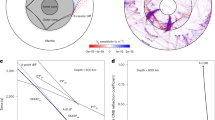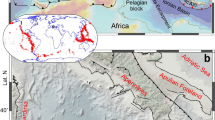Abstract
The volcanic edifice of the Hawaiian islands and seamounts, as well as the surrounding area of shallow sea floor known as the Hawaiian swell, are believed to result from the passage of the oceanic lithosphere over a mantle hotspot1,2,3. Although geochemical and gravity observations indicate the existence of a mantle thermal plume beneath Hawaii4,5,6, no direct seismic evidence for such a plume in the upper mantle has yet been found. Here we present an analysis of compressional-to-shear (P-to-S) converted seismic phases, recorded on seismograph stations on the Hawaiian islands, that indicate a zone of very low shear-wave velocity (< 4 km s-1) starting at 130–140 km depth beneath the central part of the island of Hawaii and extending deeper into the upper mantle. We also find that the upper-mantle transition zone (410–660 km depth) appears to be thinned by up to 40–50 km to the south-southwest of the island of Hawaii. We interpret these observations as localized effects of the Hawaiian plume conduit in the asthenosphere and mantle transition zone with excess temperature of ∼300 °C. Large variations in the transition-zone thickness suggest a lower-mantle origin of the Hawaiian plume similar to the Iceland plume7, but our results indicate a 100 °C higher temperature for the Hawaiian plume.
This is a preview of subscription content, access via your institution
Access options
Subscribe to this journal
Receive 51 print issues and online access
$199.00 per year
only $3.90 per issue
Buy this article
- Purchase on Springer Link
- Instant access to full article PDF
Prices may be subject to local taxes which are calculated during checkout




Similar content being viewed by others
References
Wilson, J. T. A possible origin of the Hawaiian Islands. Can. J. Phys. 41, 863–870 (1963).
Morgan, W. J. Convection plumes in the lower mantle. Nature 230, 42–43 (1971).
Morgan, J. P., Morgan, W. J. & Price, E. Hotspot melting generates both hotspot volcanism and hotspot swell? J. Geophys. Res. 100, 8045 –8062 (1995).
Hofmann, A. W. Mantle geochemistry: the message from oceanic volcanism. Nature 385, 219–229 ( 1997).
Watson, S. & McKenzie, D. Melt generation by plumes: A study of Hawaiian volcanism. J. Petrol. 32, 501 –537 (1991).
Ribe, N. M. & Christensen, U. Three-dimensional modelling of plume-lithosphere interaction. J. Geophys. Res. 99, 669–682 (1994).
Shen, Y., Solomon, S. C., Bjarnason, I. Th. & Wolfe, C. J. Seismic evidence for a lower-mantle origin of the Iceland plume. Nature 395, 62–65 ( 1998).
Russel, S. A., Lay, T. & Garnero, E. J. Seismic evidence for small-scale dynamics in the lowermost mantle at the root of the Hawaiian hotspot. Nature 396, 255–258 (1998).
Ji, Y. & Nataf, H.-C. Detection of mantle plumes in the lower mantle by diffraction tomography: Hawaii. Earth Planet. Sci. Lett. 159, 99–115 ( 1998).
Bock, G. Long-period S to P converted waves and the onset of partial melting beneath Oahu. Geophys. Res. Lett. 18, 869– 872 (1991).
Woods, M. T., Leveque, J. -J., Okal, E. A. & Cara, M. Two-station measurements of Rayleigh wave group velocity along the Hawaiian Swell. Geophys. Res. Lett. 18, 105– 108 (1991).
Priestley, K. & Tilmann, F. Shear-wave structure of the lithosphere above the Hawaiian hot spot from two-station Rayleigh wave phase velocity measurements. Geophys. Res. Lett. 26, 1493 –1496 (1999).
Nishimura, C. & Forsyth, D. Rayleigh wave phase velocities in the Pacific with implications for azimuthal anisotropy and lateral heterogeneities. Geophys. J. Int. 94, 479– 501 (1988).
Yuan, X., Ni, J., Kind, R., Mechie, J. & Sandvol, E. Lithospheric and upper mantle structure of southern Tibet from a seismological passive source experiment. J. Geophys. Res. 102, 27491–27500 ( 1997).
Kosarev, G. et al. Seismic evidence for a detached Indian lithospheric mantle beneath Tibet. Science 283, 1306– 1309 (1999).
Bina, C. R. & Helffrich, G. Phase transition Clapeyron slopes and transition zone seismic discontinuity topography. J. Geophys. Res. 99, 15853–15860 ( 1994).
Sobolev, S. V. et al. Upper mantle temperatures from teleseismic tomography of French Massif Central including effects of composition, mineral reactions, anharmonicity, anelasticity and partial melt. Earth Planet. Sci. Lett. 139, 147–163 (1996).
Karato, S. & Jung, H. Water, partial melting and the origin of the seismic low velocity and high attenuation zone in the upper mantle. Earth Planet. Sci. Lett. 157, 193– 207 (1998).
Sobolev, A. V. & Nikogosian, I. K. Petrology of long-lived mantle plume magmatism: Hawaii, Pacific and Reunion Island, Indian Ocean. Petrology 2, 111– 144 (1994).
Hirth, G. & Kohlstedt, D. L. Water in the oceanic upper mantle: implications for rheology, melt extraction and the evolution of the lithosphere. Earth Planet. Sci. Lett. 144, 93–108 (1996).
Gaherty, J. B., Jordan, T. H. & Gee, L. S. Seismic structure of the upper mantle in a central Pacific corridor. J. Geophys. Res. 101, 22291–22309 (1996).
McKenzie, D. & Bickle, M. J. The volume and composition of melt generated by extension of the lithosphere. J. Petrol. 29, 625–679 (1988).
Hauri, E. H., Lassiter, J. C. & DePaolo, D. J. Osmium isotope systematics of drilled lavas from Mauna Loa, Hawaii. J. Geophys. Res. 101, 11793–11806 (1996).
Hilton, D. R., McMurtry, G. M. & Goff, F. Large variations in vent fluid CO2/3He ratios signal rapid changes in magma chemistry at Loihi seamount, Hawaii. Nature 396, 359– 362 (1998).
Ekstrom, G. & Dziewonski, A. M. The unique anisotropy of the Pacific upper mantle. Nature 394, 168– 172 (1998).
Nataf, H. -C. & VanDecar, J. Seismological detection of a mantle plume? Nature 364, 115– 120 (1993).
Ribe, N. M. & Christensen, U. R. The dynamical origin of Hawaiian volcanism. Earth Planet. Sci. Lett. 171, 517–531 (1999).
Ito, G., Shen, Y., Hirth, G & Wolfe, C. J. Mantle flow, melting, and dehydration of the Iceland mantle plume. Earth Planet. Sci. Lett. 165, 81–96 ( 1999).
Vinnik, L., Chevrot, S. & Montagner, J. P. Evidence for a stagnant plume in the transition zone? Geophys. Res. Lett. 33, 149– 163 (1997).
Kennett, B. L. N. Seismological Tables (Research School of Earth Sciences, Australian National University, Canberra, 1991).
Acknowledgements
We thank IRIS/GEOSCOPE for making the KIP data available to us, P. Dawson and B. Chouet for retrieving the seismic data from the broadband stations on the island of Hawaii, H. Kämpf for discussions, and G. Helffrich for comments on the manuscript. This work was supported by the Deutsche Forschungsgemeinschaft within the International Continental Drilling Project (ICDP) and the GeoForschungsZentrum Potsdam.
Author information
Authors and Affiliations
Corresponding author
Supplementary Information
Rights and permissions
About this article
Cite this article
Li, X., Kind, R., Priestley, K. et al. Mapping the Hawaiian plume conduit with converted seismic waves. Nature 405, 938–941 (2000). https://doi.org/10.1038/35016054
Received:
Accepted:
Issue Date:
DOI: https://doi.org/10.1038/35016054
This article is cited by
-
Fractional crystallisation of eclogite during the birth of a Hawaiian Volcano
Nature Communications (2022)
-
The M w 6.9 Sikkim–Nepal earthquake of September 2011: a perspective for wrench faulting in the Himalayan thrust zone
Natural Hazards (2015)
-
Tides as drivers of plates and criticism of mantle convection
Acta Geodaetica et Geophysica (2015)
-
Phase relations and melting of carbonated peridotite between 10 and 20 GPa: a proxy for alkali- and CO2-rich silicate melts in the deep mantle
Contributions to Mineralogy and Petrology (2014)
-
Seismic imaging of melt in a displaced Hawaiian plume
Nature Geoscience (2013)
Comments
By submitting a comment you agree to abide by our Terms and Community Guidelines. If you find something abusive or that does not comply with our terms or guidelines please flag it as inappropriate.



